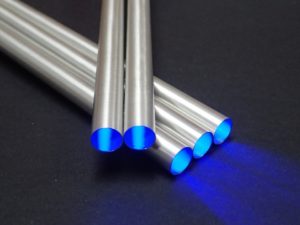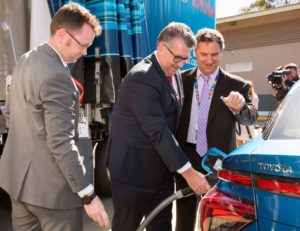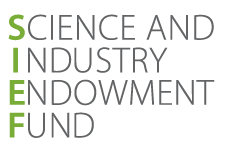Hydrogen generator for FCV refuelling – H2 Generation
SIEF supports high purity hydrogen generation technologies for fuel cell vehicles
Background
Growing global demand for clean hydrogen (H2) fuel is driving interest and momentum globally with North Asia and Europe actively investigating hydrogen-based transportation and energy systems.
This presents a significant opportunity for the establishment of an Australian renewable hydrogen export industry. The nation has access to vast energy resources through sun, wind, biomass, natural gas, and coal, all of which can be used as feedstock for the production of ammonia. Using ammonia (NH3) as a carrier, renewable hydrogen produced in Australia can be readily distributed, at large scale, to emerging markets in Japan, Korea and Europe using existing infrastructure for ammonia transport. The gap in this supply chain is a technology that can efficiently and inexpensively convert ammonia into high-purity hydrogen at or near the point of use. Hydrogen must be at least 99.999% pure to meet fuel cell vehicle (FCVs) requirements.

metal membrane tubes
CSIRO’s metal membrane tubes, which were scaled up to 500mm in length, allowing a production scale of 5kgH2/day under the SIEF EDP project.
SIEF’s Role
The 2-year SIEF project (Jan 2017-2019) aimed at addressing this industry need by:
- completing the final development step of CSIRO’s metal membrane technology (Figure 1), and
- incorporating this membrane technology into a 5-15 kg H2/day proof-of-concept plant for the refuelling of Australia’s first hydrogen-powered fuel cell vehicles.
In this $3.4 million project, 50% of the project cost was funded from the SIEF as an ‘Experimental Developmental Program’ (EDP); the remainder was contributed by CSIRO. BOC provided over $100,000 of in-kind gas products and equipment as well as technical expertise.
The challenge
Hydrogen has the potential to power vehicles and industry around the world; however, due to its low density, it is notoriously difficult to store and transport.
The available technologies such as compression, liquefaction of hydrogen (producing liquid H2, below -253°C) or storing in metal hydride, incur a significant energy penalty, are poorly suited to export thereby offering a complex, inefficient and/or relatively expensive process for the intended utilization.
The response
CSIRO’s solution addresses the conversion of ammonia to high-purity hydrogen at, or near, the point of use. Ammonia stores almost twice as much hydrogen than liquid hydrogen and is easier to ship and distribute, opening up possibilities for a renewable energy export market—as long as it can be converted to high purity hydrogen effectively and efficiently.
Ammonia (NH3) has long been considered a prospective H2 storage and transport medium, exhibiting a higher volumetric H2 density than liquid H2, through liquid-phase storage at mild pressure. In the Australian context, the financial and technical barriers to using ammonia as a hydrogen carrier are much lower compared to other available options (methanol/ ethanol/ toluene/ organic chemical hydrides) due to existing infrastructure and industry to support transport/storage of NH3 at large-scale.
There is currently a significant glut in ammonia production capacity: current capacity will soon reach 250 Mt per annum (current production is 200 Mt per annum). Not only can the ammonia industry accommodate a shift to renewable hydrogen production, but the industry is actively seeking an opportunity to use this excess capacity.
The project team developed a metal membrane reactor which allows hydrogen to pass, while blocking all other gases. By coupling membranes with a suitable catalyst for ammonia decomposition, pure hydrogen can be extracted from ammonia efficiently. There is an opportunity for this technology to influence the design of, and to be a key component of equipment and devices in, ammonia-hydrogen distribution and refuelling systems.
Outputs
From a technology perspective, this project has moved the technology readiness level (TRL) of the suite of technologies from 4 to 6:
- From TRL 4, sub-systems being separately validated in a laboratory environment with prototyping field trials in a representative environment
- To TRL 6, all sub-systems integrated into a single demonstration system, successfully producing high purity H2 from ammonia, used to successfully refuel commercial fuel-cell vehicles from Toyota (Mirai) and Hyundai (Nexo).
This is a critical (and difficult) stage of any process moving towards large-scale industrial deployment. Specific outputs include:
CFD Models for the H2 Generation System
A 3D computational fluid dynamics (CFD) model of the H2 generation system, critical to the design of the demonstration-scale system, ongoing technology commercialisation and scale-up.
CSIRO’s Metal Membrane Production
An innovative process for manufacturing vanadium alloy tubes, a key component in scaling up this technology from lab to commercialisation scale. This led to the successful manufacture of 20 membrane tubes, at the greater lengths of up to 500 mm.
Demonstration of CSIRO metal membrane as being highly permeable for H2, resistant to embrittlement and low cost for manufacturing.
CSIRO’s H2 Generation System
The demonstration H2 generation system, at the scale of 5-15 kg H2/day operational for > 1,000 hours with an average >80% NH3 conversion efficiency and >80% H2 recovery rates, higher than targeted thereby proving the viability of the technology and without any issues with system performance.
H2 Generation for Fuel-Cell Electric Vehicles (FCEVs)
Demonstration of higher purity of generated compressed H2 than required standard purity requirements (ISO14687-2). Further evidence that purity analysis will be an ongoing aspect and challenge for the emerging hydrogen energy industry.
Publications
- Dolan, M. D., Viano, D. M., Langley, M. J., & Lamb, K. E. (2018). Tubular vanadium membranes for hydrogen purification. Journal of Membrane Science, 549, 306-311. doi:https://doi.org/10.1016/j.memsci.2017.12.031
- Hla, S. S., & Dolan, M. D. (2018). CFD modelling of a membrane reactor for hydrogen production from ammonia. IOP Conference Series: Materials Science and Engineering, 297, 012027. doi:10.1088/1757-899x/297/1/012027
- Lamb, K. E., Viano, D. M., Langley, M. J., Hla, S. S., & Dolan, M. D. (2018). High-Purity H2 Produced from NH3 via a Ruthenium-Based Decomposition Catalyst and Vanadium-Based Membrane. Industrial & Engineering Chemistry Research, 57(23), 7811-7816. doi:10.1021/acs.iecr.8b01476
- Lamb, K., Hla, S. S., & Dolan, M. (2019). Ammonia decomposition kinetics over LiOH-promoted, α-Al2O3-supported Ru catalyst. International Journal of Hydrogen Energy, 44(7), 3726-3736. doi:https://doi.org/10.1016/j.ijhydene.2018.12.123
Outcomes

Demonstration of CSIRO's hydrogen generation technology to produce high purity hydrogen for fuel cell vehicles.
Refilling with compressed hydrogen generated using CSIRO’s hydrogen production system by Hon Keith Pitt MP, together with Dr Larry Marshall, Chief Executive of CSIRO and Matthew Macleod, Manager of Advanced Technology Vehicles and Site Development, Toyota Motor Corporation Australia. (Source: CSIRO)
The technical validity of the technology was demonstrated during the project at CSIRO Pullenvale site on 8 August 2018 where, in conjunction with project partners, CSIRO successfully refuelled two fuel cell electric vehicles, a Toyota Mirai and a Hyundai Nexo, using hydrogen produced from the demonstration rig. This event was covered by multiple media outlets and was world’s first demonstration of fuel-cell vehicles refuelling with hydrogen derived directly from ammonia.
Uptake
The advancement in TRL of the CSIRO technology, coupled with the increased awareness as mentioned above, has led to the execution of a collaborative partnership agreement with Fortescue Metals Group Ltd (FMGL). The metal membrane technology is now licenced to FMGL which is funding the development of a larger-scale pilot plant (200 kg/day). Following the successful outcomes of this project, the team is working on increasing the technology in scale and deploying it in several larger-scale demonstrations in Australia and internationally, in a partnership with FMGL.
Co-development with FMGL to commercialise has other benefits that include:
- Local company supporting the commercialisation – more benefits to Australia
- Improving capabilities to support domestic needs (emissions reduction, mining decarbonisation, etc) as well as a new export industry
- Catalysing wider RE/Hydrogen industry growth through bringing in traction from other larger companies.
External Engagement
The impacts of this project are both technological and more widely relevant to the emerging hydrogen energy industry. During this project, two press releases were issued by CSIRO team, first one in May 2017 and second one in August 2018 on the H2 refuelling demonstration day. These press releases generated a large number of media queries and stories not only on CSIRO technology, but also on the use of hydrogen itself as a sustainable transport fuel for the future. Due to the growing awareness, other Australian initiatives that aim at generating renewable and sustainable hydrogen to export to countries like Japan and Korea, for the development of the FCEV market are gaining traction.
A number of external collaborators/partners made this SIEF EDP project a success. These included:
- BOC – which provided over $100,000 of in-kind gas products (including ammonia and hydrogen) and equipment as well as technical expertise.
- Toyota – which provided for the demonstration, two Mirai FCEVs and a hydrogen refuelling truck, which took CSIRO’s generated H2 at 150 bar and compressed this to 700 bar for refuelling the FCEVs.
- Hyundai – which also provided their newest FCEV model, the Nexo, for the demonstration.
- Queensland Department of Environment and Science and Thomson Environmental Systems – which supported gas analysis for H2 purity.
Roadmap from R&D to benefits for Australia
Through this partnership and further commercialisation activities, CSIRO has demonstrated its role in showing how R&D enables and supports new industries. This technology has the potential to be another key enabler and catalyst for the start-up of an Australian hydrogen value chain and export economy.
CSIRO continues to be highly active across the entire hydrogen value chain (including solar photovoltaics, solar thermal, grid management, water electrolysis, ammonia synthesis, direct ammonia utilisation via combustion and/or fuel cells, as well as hydrogen production).
More information on Australia-scale benefits:
- CSIRO’s National Hydrogen Roadmap
- CSIRO’s Hydrogen Future Science Platform (FSP)
- CSIRO’s Hydrogen Mission
Longer-Term Outcomes
A successful ammonia-to-hydrogen technology will play a critical role to demonstrate a viable solution. To move to a commercial undertaking, the team is developing internationally-linked demonstration projects. Any longer-term outcomes will require the ability to plan and deliver these projects with government and industrial partners.
The final step for commercialisation of this technology requires engagement with H2 and fuel cell vehicles industries that can facilitate the incorporation of commercial-scale CSIRO H2 generating system, and provide validation of the first step, for refuelling to day-to-day HFCV for real-life customers.
Impacts
Economic
The establishment of a new renewable hydrogen export industry where hydrogen produced from renewable sources can be exported in the form of ammonia. This technology can also improve Australia’s fuel security and create new industries/ jobs and market niches.
Environmental
The uptake of this technology can significantly reduce both national and global emissions from CO2 as well as other sources such as coal, oil across the transport, power and industrial sectors. It can also improve air quality through the elimination of particulates generated from internal combustion engines and other emissions associated with coal mining.
Social
Better health and wellbeing associated with hydrogen as a clean energy source. The revitalisation of regional communities through employment in new hydrogen-based industries.
Grimpacts (i.e. potential negative impacts)
There is potential that the major uptake of a global hydrogen economy will increase fugitive (uncontrolled) emissions and therefore elevated concentrations of H2 in the upper atmosphere. CSIRO is researching to investigate the impact (if any) of higher atmospheric concentrations of hydrogen (H2) and ammonia (NH3) on atmospheric chemistry.
Program’s Counterfactual
The renewable energy export industry will rely on carriers such as liquid H2 and ammonia. Without this developmental work, Australia risks falling behind the rest of the world and may miss the opportunity to become a dominant power in the renewable energy realm. Solutions for renewable hydrogen production at scale would be delayed for the nation.
Without this SIEF co-funded work, FMGL would not have committed to supporting this work so publicly, and so early. That has interesting ramifications around the role of local companies in the global H2 industry, around the pace of change in Australia and the role of large corporations.
Potential Future Impacts
A successful ammonia-to-hydrogen technology will play a critical role to demonstrate a viable solution. To move to a commercial undertaking, the team is developing internationally linked demonstration projects. Any longer-term outcomes will require the ability to plan and deliver these projects with government and industrial partners.
The final step for commercialisation of this technology requires engagement with H2 and fuel cell vehicles industries that can facilitate the incorporation of commercial-scale CSIRO H2 generating system, and provide validation of the first step, for refuelling to day-to-day HFCV for real-life customers.
SIEF’s Role
Technology development and translation
Before the SIEF project, the CSIRO membrane technology was validated only on a prototype scale in isolation of the NH3 cracking process, membrane production was limited to laboratory-scale processes, and there was limited understanding of the industrial requirements of large-scale hydrogen energy applications. There was industry uncertainty regarding the quality of the H2 produced, and a demonstration of the complete technology was needed to allow consideration of new commercialisation pathways.
SIEF funding for this project was instrumental in realising the value-proposition of this work and facilitated the translation of knowledge to a commercial solution. The support enabled successful scaling up of the technology and demonstration of its potential as the critical ‘last step’ in ammonia-based hydrogen distribution.
